Weaver species
Choose different species from drop-down list and press 'Go' button. See Full species list.Scaly-feathered Finch Sporopipes squamifrons
IUCN: Least concern Discovery: 037Categories: cooperative, acacias, Nest use, Histurgops+Sporopipes,
News items about species
Discovery
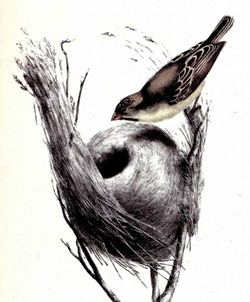
figure from Smith 1844a 
figure from wikipedia 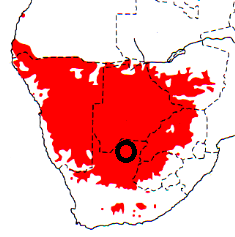
distribution, type locality circled IntroductionThe Scaly-feathered Finch was collected and formally described by Andrew Smith, a Scottish surgeon, explorer, ethnologist and zoologist. Smith moved to Grahamstown in 1820 as a doctor, and in 1825 he was appointed as the first Superintendent of the South African Museum of natural history in Cape Town.Smith organised an expedition to the interior and he travelled to near the Botswana border in 1834-35, collecting many new birds, reptiles, mammals and other taxa along the way. Smith noted that the Scaly-feathered Finch was common north of Latakoo, and that he only once saw it south of that locality, namely, near the source of the Great Fish River. Vincent 1935 argues that the correct type-locality depends on which of the two localities Smith first visited. Smith's expedition account shows that he travelled from the coast to Graaf Reinet and then to Latakoo (near Kuruman). Smith first saw the species near the source of the Great Fish River (near Graaf Reinet), but it is unclear if he collected a specimen here. Clancey (1957) and Oschadleus (2007) argued that the Scaly-feathered Finch does not occur near Graaf Reinet and thus Latakoo (ie Kuruman) should be taken as the type locality. Currently Kuruman is favoured as the type locality. Andrew Smith wrote detailed notes in his diary on 19 March 1835 about the Scaly-feathered Finch at the Moshawing River, near Latakoo, where he also found a nest with 2 chicks. The first illustration of a Scaly-feathered Finch was published by Andrew Smith in 1844 in his well known work, Illustrations of the Zoology of South Africa, and the Scaly-feathered Finch with its nest was painted by George Henry Ford. Scientific citationEstrelda squamifrons Smith 1836; Rep. Exped. Centr. Africa, p.49; South Africa; restricted to Kuruman, northern Cape Province by Clancey (1957, Durban Mus. Novit., 5, p.50).Meaning of namessquamifrons Latin: squameus, scaly; frons, the forehead or brow.First English nameThe Scale-headed Weaver-Finch (Reichenbach 1863).Alternate namesDamara Scaly-feathered Weaver, Scaly Weaver, Scaly-crowned Weaver, Scaly-feathered Weaver Bird, Scaly-fronted Weaver, Scuttelated Finch, The Scale-headed Weaver-Finch.CollectorAndrew Smith.Date collected19 March 1835.Locality collectedMoshawing River, Kuruman.Type specimensThere are at least 4 type specimens in different museums: BM 1872.10.4.92, ANSP 13911, Merseyside D1774, and Merseyside D1774a. |
The above is based on Weaver Wednesday 2, a weekly series about the discovery of each weaver species.
This species text first appeared as
Weaver Wednesday [154] - Discovery [37]: Scaly-feathered Finch on 2015-05-27
1. Basic biology
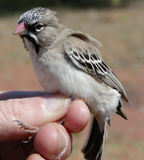
Identification. There are two species in the genus Sporopipes, this name meaning "to look for seeds". They are very small, social weavers of semi-arid parts of Africa. Both species have moustachial stripes but they do not overlap in distribution. The sexes are alike. The young have the crown and forehead dull grey-brown with no scaling, and the malar stripes are absent. Distribution.
Habitat. The Scaly-feathered Finch inhabits dry Acacia savanna, arid scrub and bush along dry watercourses, and shrubs near houses. This species is found in pairs or flocks of up to 20 birds, and it regularly flocks with waxbills. Scaly-feathered Finches sleep communally in a nest through the year, with up to 12 birds using one nest, to keep warm on icy winter nights. Resting in the nest during the day also enables the birds to avoid the hottest times in summer. Food.
The Scaly-feathered Finch forages on the ground, feeding mainly on small seeds, with insects being fed to their young. They drink when water is available but, remarkably, they can survive for months without drinking as they can produce metabolic water from their diet of dry seeds.
Breeding. The Scaly-feathered Finch is monogamous, and some courtship behaviour resembles that of waxbills. It is suspected to be a cooperative breeder, but this needs to be investigated. The Scaly-feathered Finch nest is an untidy, rugby-ball shaped mass of grass stems and grass seed heads. There is usually one nest, but sometimes nests from previous seasons may be present. The nest is placed in trees or bushes at 1-4 m above the ground. It may use May the old cup nest of a shrike or flycatcher and build a roof over it. The incubation period is fairly short at 10-12 days, as is found in many passerines in arid areas. Incubation is by the female, while both sexes feed the nestlings. The young continue to sleep in the nest for several weeks. |
The above is based on Weaver Wednesday, a weekly series about weaver species.
This species text first appeared as
Weaver Wednesday [7]: Scaly-feathered Finch on 2012-08-01
2. Breeding facts
| Pair bond Monogamous, at least within a breeding season Breeding season at any time of year when conditions favourable; peak months Feb-Mar in Zambia, Dec-Apr in Botswana, Jan-Mar in Zimbabwe and Jan-Jun in South Africa Nest site placed in tree and usually 1-4 m above ground up to 6 m in tall tree; sometimes roofs over old cup-nest of shrike (Laniidae) or flycatcher (Muscicapidae), or utilizes old nest of another weaver, e.g. Ploceus velatus Nest building ln captivity, female built nest while male brought material Colony size n/a Clutch size 3-5 Egg colour greenish, bluish or pale cream, densely freckled with grey to brownish Egg size average size 15.7 x 11.3 mm (106 eggs from South Africa) Incubation incubation by female alone, period 10-12 days Chicks and nestling period chicks fed by both sexes, nestling period 14-18 days |
Breeding information based on Handbook of the Birds of the World, Vol. 15.
3. Photos of Weaver Nests
 Vm 30203 |  Vm 30196 | 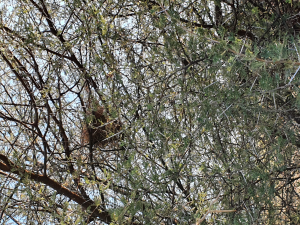 Vm 30041 |  Vm 29972 |  Vm 29941 |  Vm 29585 |
Thumb-nails of most recent PHOWN records - click on one to see its full record
See all PHOWN records for this species here.
PHOWN (Photos of Weaver Nests) provides valuable info on breeding distribution and colony sizes of weavers.
You can contribute by registering and submitting photos at Virtual Museum webpage.
4. Breeding distribution
Google map showing distribution (For species with small ranges you need to zoom in at the correct area to see the range):
yellow blob - range of weaver species; read more about this here.
![]() - PHOWN records with photos
- PHOWN records with photos
![]() - PHOWN records with no photos (Nest Record Cards, other records)
- PHOWN records with no photos (Nest Record Cards, other records)
![]() - Birdpix records
- Birdpix records
![]() - comments on out of range records, or interesting records
- comments on out of range records, or interesting records
![]() - type locality
- type locality
CLICK on the marker on the map to see individual record details.
5. Range changes
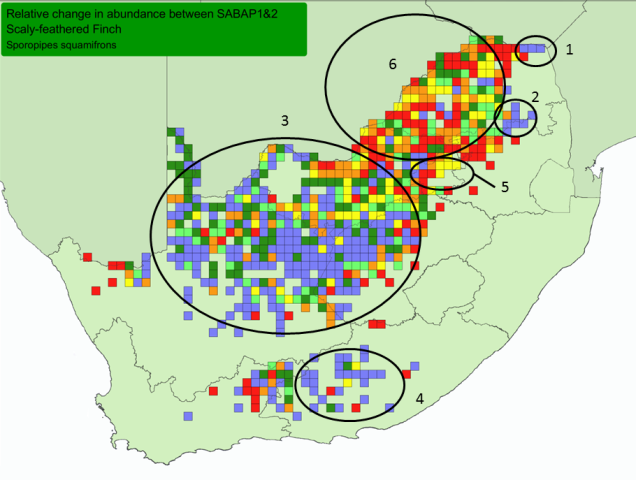
Red, orange and yellow = cells with very large, large, and small relative decreases Blue, dark green and light green = cells with very large, large and small relative increases. Cells = quarter-degree grid cells; Only cells with at least 4 checklists in both SABAP1&2 shown. All cells had this species recorded in SABAP1 or in SABAP2 or in both (more about interpretation at Biodiversity Observations 7.62: 1-13).
Range changes in SA
Areas with very large increases include:
Large decreases appear to have occurred:
Range changes elsewhereAngola: range extends further than mapped in (Fry 2004a) (in prep.).Zimbabwe: range increasing around Bulawayo (Dean 1963a). | |||||||||||||||||||||||||||||||||||
The above is based on Weaver Wednesday 3, a weekly series about range changes in South African weaver species.
This species text first appeared as
Weaver Wednesday 3 [241] - Range changes [4]: Scaly-feathered Finch on 2017-01-25








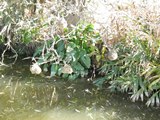


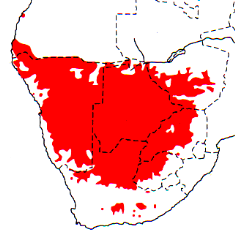 The Scaly-feathered Finch is found through southern Africa and the extreme southern parts of Angola and Zambia. There are disjunct populations in the Eastern and Western Cape. For changes in abundance in SOuth Africa, see
The Scaly-feathered Finch is found through southern Africa and the extreme southern parts of Angola and Zambia. There are disjunct populations in the Eastern and Western Cape. For changes in abundance in SOuth Africa, see 
